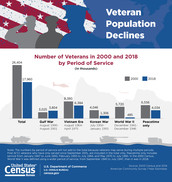
|
Census Bureau Releases New Report on Veterans

JUNE 2, 2020 — A new report released today by the U.S. Census Bureau shows that while the overall population of veterans is declining, the number of female veterans is on the rise and Post 9-11 veterans have the highest rate of service-connected disability compared to any other group of veterans.
The report, Those Who Served: America’s Veterans From World War II to the War on Terror, looks at the characteristics of the 18.0 million or about 7% of the adult population who were veterans of the U.S. armed forces in 2018.
|

Highlights include:
- The number of veterans in the United States declined by about a third, from 26.4 million to 18.0 million between 2000 and 2018.
- Fewer than 500,000 World War II veterans were alive in 2018, down from 5.7 million in 2000.
- Women make up a growing share of veterans. About 1.7 million, or 9% of veterans, were women in 2018. It is projected that number will jump to 17% by 2040.
- The largest cohort of veterans alive in 2018 served during the Vietnam Era (6.4 million), which lasted from 1964 to 1975. The second-largest cohort of living veterans served during peacetime only (4.0 million).
- The median age of veterans in 2018 was 65. By service period, Post-9/11 veterans were the youngest with a median age of about 37; Vietnam Era veterans had a median age of about 71; and World War II veterans were the oldest with a median age of about 93.
- Veterans from recent service periods have the highest levels of education. More than three-quarters of Post-9/11 and Gulf War veterans had at least some college experience, and more than one-third of Gulf War veterans had a college degree.
- Post-9/11 veterans had a 43% chance of having a service-connected disability, after accounting for differences in demographic and social characteristics among veterans —significantly higher than that of veterans from other periods.
- Among veterans who had a service-connected disability, Post-9/11 veterans had a 39% chance of having a disability rating of 70% or more — significantly higher than for veterans from other periods.
This report uses data from the 2018 American Community Survey (ACS). The ACS is a nationwide survey designed to provide timely and reliable data every year on the demographic, social, economic and housing characteristics of the nation, states, counties and other localities. The survey has an annual sample size of about 3.5 million addresses across the United States and Puerto Rico, and includes both housing units and group quarters. The ACS is conducted in every county throughout the nation. The ACS 1-year data are released for geographic areas with populations of 65,000 or greater. The ACS 5-year data are released for all geographic areas. For information on the ACS sample design and other topics, visit <www.census.gov/programs-surveys/acs/>.
Data in this report are subject to sampling and nonsampling error. Comparisons of estimates in the report have taken sampling error into account and are significant at the 90% confidence level or higher, unless otherwise noted. Because of rounding, some details may not sum to totals. For information on sampling and estimation methods, confidentiality protection, and sampling/nonsampling errors, see the Accuracy of the Data documents for 2018.
No news release associated with this product. Tip sheet only.
###
|
|
Resources for the Media
We're here to help you get the most out of our tipsheets, press releases, trainings, and media services. If you have a question, give us a call at 301-763-3030 or contact our Public Information Office at pio@census.gov.
Kristina Barrett
|